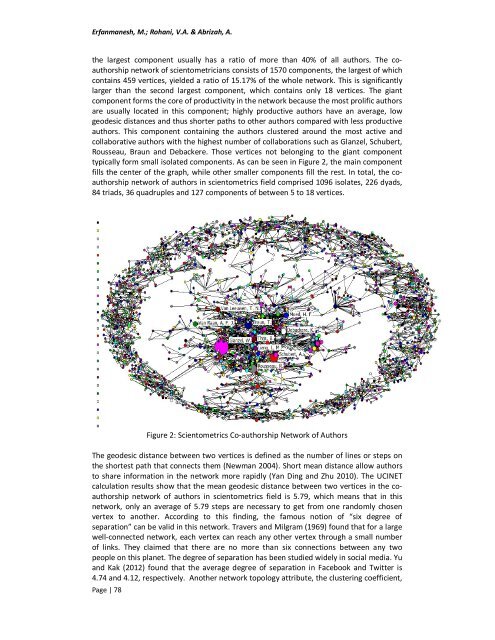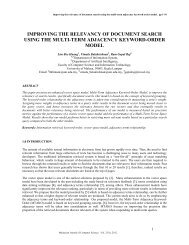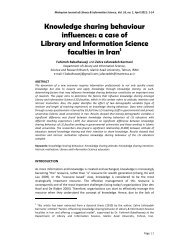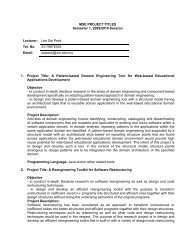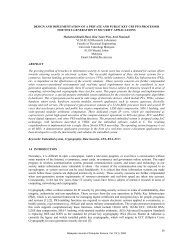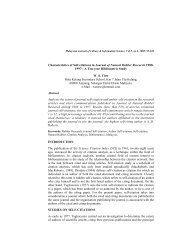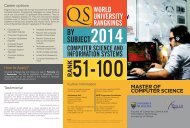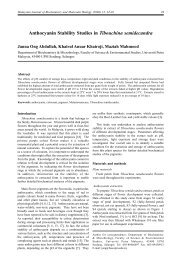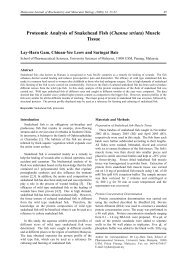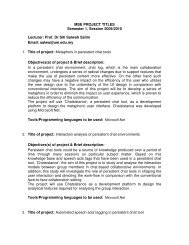Erfanmanesh, M.; Rohani, V.A. & Abrizah, A.the largest component usually has a ratio <strong>of</strong> more than 40% <strong>of</strong> all authors. The co<strong>authorship</strong><strong>network</strong> <strong>of</strong> scientometricians consists <strong>of</strong> 1570 components, the largest <strong>of</strong> whichcontains 459 vertices, yielded a ratio <strong>of</strong> 15.17% <strong>of</strong> the whole <strong>network</strong>. This is significantlylarger than the second largest component, which contains only 18 vertices. The giantcomponent forms the core <strong>of</strong> productivity in the <strong>network</strong> because the most prolific authorsare usually located in this component; highly productive authors have an average, lowgeodesic distances and thus shorter paths to other authors compared with less productiveauthors. This component containing the authors clustered around the most active andcollaborative authors with the highest number <strong>of</strong> <strong>collaboration</strong>s such as Glanzel, Schubert,Rousseau, Braun and Debackere. Those vertices not belonging to the giant componenttypically form small isolated components. As can be seen in Figure 2, the main componentfills the center <strong>of</strong> the graph, while other smaller components fill the rest. In total, the co<strong>authorship</strong><strong>network</strong> <strong>of</strong> authors in <strong>scientometrics</strong> field comprised 1096 isolates, 226 dyads,84 triads, 36 quadruples and 127 components <strong>of</strong> between 5 to 18 vertices.Page | 78Figure 2: Scientometrics <strong>Co</strong>-<strong>authorship</strong> Network <strong>of</strong> AuthorsThe geodesic distance between two vertices is defined as the number <strong>of</strong> lines or steps onthe shortest path that connects them (Newman 2004). Short mean distance allow authorsto share information in the <strong>network</strong> more rapidly (Yan Ding and Zhu 2010). The UCINETcalculation results show that the mean geodesic distance between two vertices in the co<strong>authorship</strong><strong>network</strong> <strong>of</strong> authors in <strong>scientometrics</strong> field is 5.79, which means that in this<strong>network</strong>, only an average <strong>of</strong> 5.79 steps are necessary to get from one randomly chosenvertex to another. According to this finding, the famous notion <strong>of</strong> “six degree <strong>of</strong>separation” can be valid in this <strong>network</strong>. Travers and Milgram (1969) found that for a largewell-connected <strong>network</strong>, each vertex can reach any other vertex through a small number<strong>of</strong> links. They claimed that there are no more than six connections between any twopeople on this planet. The degree <strong>of</strong> separation has been studied widely in social media. Yuand Kak (2012) found that the average degree <strong>of</strong> separation in Facebook and Twitter is4.74 and 4.12, respectively. Another <strong>network</strong> topology attribute, the clustering coefficient,
<strong>Co</strong>-<strong>authorship</strong> Network <strong>of</strong> Scientometrics Research <strong>Co</strong>llaborationindicates the extent to which vertices in a <strong>network</strong> tend to cluster together (Newman2003). It describes the probability that two <strong>of</strong> a scientist’s collaborators have themselvesco-authored a paper. <strong>Co</strong>nsidering all vertices <strong>of</strong> the <strong>network</strong>, the total clusteringcoefficient is 0.799, which indicates that the <strong>network</strong> is highly clustered. As a result, twoauthors typically have a high probability <strong>of</strong> <strong>collaboration</strong> if both have collaborated with athird author. This finding may interpret that authors tend to introduce pairs <strong>of</strong> theircollaborators to one another, encouraging new <strong>collaboration</strong>s and increasing clustering inthe <strong>network</strong> (Newman, Watts and Strogatz 2002). The short mean distance coupled withhigh clustering coefficient indicates that the co-<strong>authorship</strong> <strong>network</strong> <strong>of</strong> authors in<strong>scientometrics</strong> field seems to exhibit “small world” <strong>network</strong> properties. A “small world” is a<strong>network</strong> in which any two vertices are only a few steps apart, regardless <strong>of</strong> <strong>network</strong> size. Inthis <strong>network</strong>, vertices are not necessarily all connected to each other, yet they are easilyreachable from one another via short path (Watts and Strogatz 1998).Micro-level metrics refers to centrality, which is one <strong>of</strong> the most important and frequentlyused measurements in social <strong>network</strong> analysis. Centrality measures indicate how centralthe actor is to the <strong>network</strong>, which <strong>of</strong>fer a useful perspective for assessing <strong>research</strong>er’sperformance according to their functions and roles in the <strong>network</strong> (Benckendorff 2010).Three common centrality metrics, namely degree centrality, closeness centrality andbetweenness centrality were adopted to analyze the co-<strong>authorship</strong> <strong>network</strong> <strong>of</strong> authors in<strong>scientometrics</strong> field. Table 1 presents the top 30 authors in terms <strong>of</strong> centrality measures(degree, betweenness and closeness), productivity (number <strong>of</strong> papers in the journalScientometrics) as well as <strong>collaboration</strong> (number <strong>of</strong> co-authors). Degree centrality <strong>of</strong> avertex is the total number <strong>of</strong> links that are adjacent to this vertex (Newman 2004). In thisstudy, it refers to the total number <strong>of</strong> co-<strong>authorship</strong>s that an author has. Authors withhigher degree centrality are more central to the structure <strong>of</strong> the <strong>network</strong> and tend to havegreater capacity to influence others. The average degree centrality <strong>of</strong> authors in<strong>scientometrics</strong> co-<strong>authorship</strong> <strong>network</strong> is 4.069, while the degree distribution variessignificantly. The results show a power-law distribution with a few authors showing a highdegree centrality and majority <strong>of</strong> authors having very low degree centrality. In a dataset <strong>of</strong>3024 authors, only 650 authors (21.49%) have a degree centrality <strong>of</strong> 5 or more and onlyone author reaches the highest degree centrality <strong>of</strong> 277. The most prolific authors in terms<strong>of</strong> degree centrality are: Glanzel (277), Schubert (142), Rousseau (128), Braun (125),Debackere (67), Van Raan (58), Moed (57), Thijs (56), Van Leeuwen (53), Liang and <strong>Co</strong>urtial(47) respectively (Table 1). They are the most active and visible scientometricians with thehighest extent <strong>of</strong> <strong>collaboration</strong>. These authors with the highest degree centrality arecrucial to the robustness <strong>of</strong> the <strong>network</strong> as well as the transmission <strong>of</strong> information.Closeness centrality can be defined as how close an author is on average to all others inthe <strong>network</strong> (Benckendorff 2010). This measure can be interpreted as an indicator <strong>of</strong> theinfluence <strong>of</strong> an actor because the higher its value, the easier for that actor to obtain andspread information through the <strong>network</strong> (Martinez-Romo et al. 2008). Table 1 shows thetop 30 authors ranked on the standardized closeness centrality measure. The top scorers interms <strong>of</strong> closeness centrality are: Glanzel (0.00046983) closely followed by Rousseau(0.00046981), Meyer and Debackere (0.00046026), Kretschmer, Leta, Liang, Thijs, Wu,Persson and Moed (0.00046025). These authors are closest or more central actors <strong>of</strong> the<strong>network</strong>, because the sum <strong>of</strong> their geodesic distances to other actors is among the least.We can see that the closeness centrality <strong>of</strong> authors is very small because in such large<strong>network</strong> with more than 3000 vertexes, usually an actor is only close to a limited number<strong>of</strong> other actors.Page | 79
- Page 2 and 3: Erfanmanesh, M.; Rohani, V.A. & Abr
- Page 4 and 5: Erfanmanesh, M.; Rohani, V.A. & Abr
- Page 8 and 9: Erfanmanesh, M.; Rohani, V.A. & Abr
- Page 10 and 11: Erfanmanesh, M.; Rohani, V.A. & Abr
- Page 12 and 13: Erfanmanesh, M.; Rohani, V.A. & Abr
- Page 14 and 15: Erfanmanesh, M.; Rohani, V.A. & Abr
- Page 16 and 17: Erfanmanesh, M.; Rohani, V.A. & Abr
- Page 18 and 19: Erfanmanesh, M.; Rohani, V.A. & Abr
- Page 20 and 21: Erfanmanesh, M.; Rohani, V.A. & Abr


